Eggplant nursery method and seedling management are basically the same as for tomato, and can be referred to, and note: 1 eggplant germination is slower than tomato, germination time is 1 to 2 days longer than tomato; 2 the temperature during incubation is slightly higher than tomato 2 to 3 °C; 3 eggplant rooting is earlier, regeneration ability is poor, so when the seedlings or transplanting, as much as possible with soil, so as not to hurt the root.
2 Soil fertigation, timely transplantation: eggplant avoid continuous cropping, bogey and solanaceous crops such as tomatoes, peppers, potatoes and other continuous cropping. Spring sown eggplant can be used for overwintering or overwintering; if it is cultivated in mid-maturity or love autumn, it can pick up spring dishes such as cabbage, radish, and spinach. After the final frost covering from the end of April to mid May, colonization can be achieved earlier. Summer sowing eggplants are mostly planted after wheat harvest. The vegetable areas can be picked up from early-season cabbage, cauliflower, garlic, etc., which is called “Mai-Jin eggplantâ€.
Prior to planting in spring, the decomposed organic fertilizer should be applied to 75,000 to 90,000 kilograms per hectare, and 400 to 600 kilograms of phosphorus and potassium compound fertilizer should be used to plow, level, and do the planting. When planting, it is best to mix the biological fertilizer and the fertilizer thoroughly and spread it into the planting hole. Each 5,000 hectares of preserved seedlings will be planted and watered after planting.
3 skillfully applied topdressing: timely cultivating after planting, raising the temperature, and promoting the slow seedlings. After easing the seedlings, no drought or watering is required. If dry, a small amount of water can be poured and cultivating in time 2 or 3 times for seedlings to promote the development of the root system in depth. This will lay the foundation for the plant to expand the absorption area and flowering results. To the end of the eggplant "eye blinking" end of seedlings. In combination with watering, 15,000 kilograms of excrement and urine per hectare are used. The fertilization should not be too late or too early, but it is easy to go crazy when it is too early, and it is purple when it is too late, which affects the fruit development and the subsequent branching results. When eggplant and four-mother douche flower, it is also the time when eggplant needs fertilizer and water. Generally, it will be poured every 1 to 5 days to keep the soil moist. In combination with water, it will treat 15000 kg/ha of nitrogen or phosphorus per person per hecter. Potassium compound fertilizer 225 kg. One time after the water, one fertilizer and water alternately, that is, every 15 days to recover a fertilizer, a total of 8 to 9 times. In late-maturing cultivation, in the fruiting period, 0.2% urea or 0.3% potassium dihydrogen phosphate can be used for foliar spraying, and biogas fertilizer can also be used to spray water after dilution, which is beneficial to plant growth and fruit setting.
If there is a lack of magnesium in the soil or an excessive application of nitrogen and potassium fertilizers, the balance between the elements is destroyed, and the roots cannot absorb magnesium and induce magnesium deficiency. When the soil lacks magnesium, dolomite or calcium magnesium phosphate fertilizer can be added to the base fertilizer. In the early stage of magnesium deficiency, 405 kilograms of magnesium sulfate per hectare or foliar spray of 0.1% to 0.2% magnesium sulfate should be applied in a timely manner once a week for a total of 3 times.
During the eggplant's growth period, the temperature is too high or too low, the light is insufficient, malnutrition occurs, and the soil is suddenly dried and dampened, causing the fruit to fall. Therefore, during the rainy season, attention should be paid to the prevention of flood damage and avoid excessive application of potassium fertilizer.
Eggplant is eaten with tender fruit, generally from the flowering to the tender fruit mature takes about 20 to 25 days, should be timely harvested and marketed. The eggplant should be harvested early to facilitate future branching and fruit setting. Harvested in the morning, the fruit is fresh and shiny, and the commodity value is high.
The single dome LED series cold-light shadowless surgical lights of our factory, which are adopted LED bulbs as the light source, the OT lamp has owned the authentic cold illiminant effect, improved the characteristics of high color rendering, high gemcore, low vertifo, high equitability, low electromagnetic interference, long life span, LED bulb can be more than 50,000 hours, low power consumption etc, it is the new advanced products to instead of traditional shadowless operation lamps;

Single Dome Round Ot Lamp,Single Dome Operation Light,Single Dome Surgery Lamp,Single Dome Operating Lamp
Shandong Lewin Medical Equipment Co., Ltd. , https://www.lewinmed.com